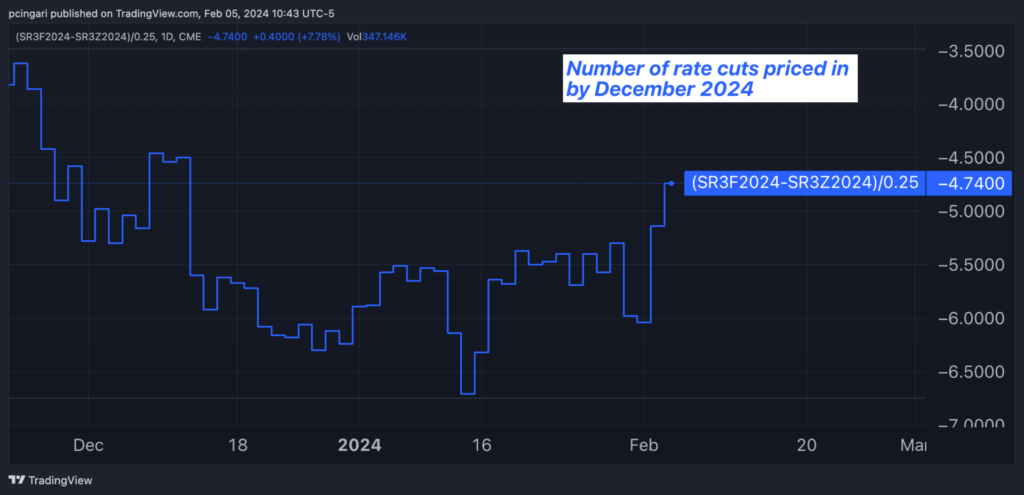Zinger Key Points
- Kashkari suggests Fed's policy may not be as tight, highlighting economic resilience and potential recalibration for neutral rate stance.
- Market reactions show declining expectations for rate cuts, with notable shifts in Fed futures and Treasury yields.
- Join Chris Capre on Sunday at 1 PM ET to learn the short-term trading strategy built for chaotic, tariff-driven markets—and how to spot fast-moving setups in real time.
Neel Kashkari, President of the Federal Reserve Bank of Minneapolis, stated Monday that the Federal Reserve’s current monetary policy might not be as tight as previously assumed, given the evolving economic conditions.
Kashkari asserted that the perceived tightness of the Federal Reserve’s monetary policy may be overestimated, especially in light of the prolonged low-rate environment before the pandemic.
His comments follow Fed Chair Jerome Powell‘s remarks during an interview with CBS’s “60 Minutes Overtime.”
Powell stated that inflation is not yet under control and emphasized that the Federal Reserve would need to see more positive data before considering a reduction in interest rates.
Reassessing Monetary Policy Tightness
“The current stance of monetary policy may not be as tight as we would have assumed,” Kashkari wrote, indicating a possible recalibration of what is considered a ‘neutral’ policy stance in the post-pandemic era.
According to the Minneapolis Fed President, the threshold for what is considered neutral, or neither stimulative nor restrictive, monetary policy could be higher in the current context, providing the Fed with more room to maneuver before adjusting interest rates.
In explaining that monetary policy might not be as tight as previously imagined, Kashkari highlighted areas of surprising strength in the economy, such as the resilience of interest-rate-sensitive sectors like construction, which has seen employment numbers rise to all-time highs despite the Fed’s tightening cycle.
Furthermore, the stability of home prices and the rise of homebuilders’ stock prices reflect a robust housing market, contributing to record household wealth levels.
Evidence Of Economic Resilience
Kashkari asserted that the U.S. economy has demonstrated surprising robustness, with growth accelerating in the second half of 2023.
Simultaneously, the rapid approach of core inflation towards the Fed’s target underscores significant progress in the inflation containment efforts.
The Minneapolis Fed President believes this reassessment allows the Federal Open Market Committee (FOMC) “time to assess upcoming economic data before starting to lower the federal funds rate, with less risk that too-tight policy is going to derail the economic recovery.”
Despite some positive trends, Kashkari acknowledges the presence of economic indicators that warrant attention. Increases in auto loan and credit card delinquencies, coupled with ongoing weaknesses in the commercial real estate sector, particularly offices, signal underlying vulnerabilities.
Market Reactions
Following remarks from Federal Reserve officials on Monday, investors have significantly scaled back their expectations for upcoming interest rate cuts. Fed futures now indicate an 84% probability of interest rates remaining unchanged in March, a substantial increase from 53% just a week ago.
The likelihood of a rate cut in May has also decreased, moving from 88% a week earlier to the current 69%. While traders still anticipate a total of almost five rate cuts by December 2024, their confidence in this outcome has somewhat diminished in recent hours.
The yield on the policy-sensitive two-year Treasury note increased by 10 basis points on Monday. Moreover, yields on longer-dated maturities rose even more sharply as investors recalibrated their expectations for future rate cuts.
The iShares 20+ Year Treasury Bond ETF Trust TLT experienced a 2% decline on Monday, following a drop of as much as 2.2% last Friday, reflecting the market’s adjusted outlook on interest rates.
Chart: Market-Implied Expectations Of Fed Interest Rate Cuts In 2024

Image: Shutterstock
Edge Rankings
Price Trend
© 2025 Benzinga.com. Benzinga does not provide investment advice. All rights reserved.
Trade confidently with insights and alerts from analyst ratings, free reports and breaking news that affects the stocks you care about.